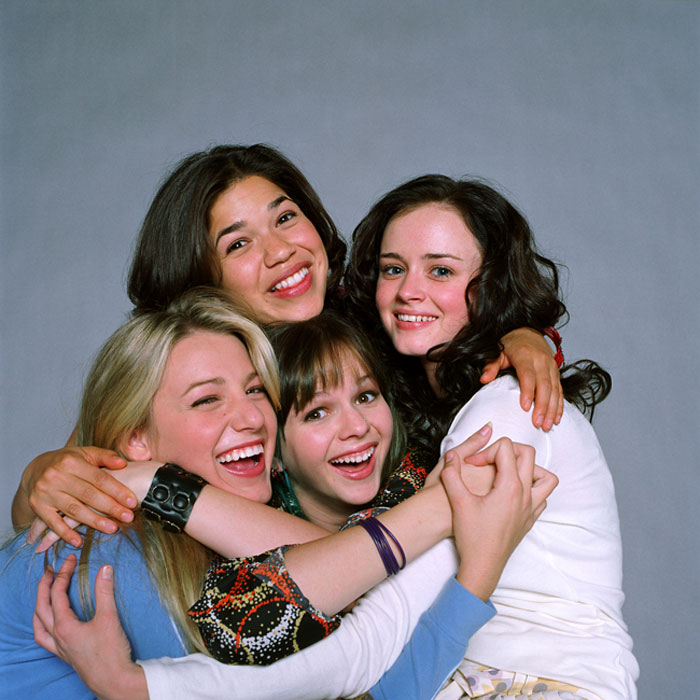The Sisterhood of the Traveling Pants
Posted on May 31, 2005 at 12:58 pm
This is a story about one summer in the life of four friends, told with sincerity, heart, and a little bit of magic — the very same qualities that made the original book and its sequels a “you have to read this” classic for young girls.
Four 16-year-olds, friends since before birth, when their mothers met in a prenatal exercise class, are about to be separated for the summer for the first time ever. Just before they leave, they find a mysterious pair of blue jeans that somehow fit each of them perfectly, even though their sizes as shapes are as different as their personalities. They decide to share the pants as a way of sharing their experiences over the summer. As they mail the pants back and forth to each other, the jeans will help them share their stories and stay connected.
The first to wear the pants is shy artist Lena (Alexis Bledel of television’s Gilmore Girls) goes to Greece to visit her grandparents. On the island of Santorini she meets Kostas. Despite a multi-generation feud between their families — and a promise never to see him again, Lena and Kostas fall in love.
Outgoing and athletic Bridget (Blake Lively) goes to soccer camp. She thinks a romance with her handsome coach is what she needs to make up for the emptiness that she has felt since her mother died.
 Aspiring writer Carmen (America Ferrera of Real Women Have Curves) goes to South Carolina to see her father (Bradley Whitford), who did not tell her that he was living with a woman (Nancy Travis) with two children and planning to get married.
Aspiring writer Carmen (America Ferrera of Real Women Have Curves) goes to South Carolina to see her father (Bradley Whitford), who did not tell her that he was living with a woman (Nancy Travis) with two children and planning to get married.
And rebellious would-be film-maker Tibby (Amber Tamblyn of television’s Joan of Arcadia) stays home, working at a huge discount store called Wallman’s and trying to make a movie about how bleak and meaningless everything is. She meets a girl named Bailey (Jenna Boyd) who becomes her film crew.
Each of the girls wears the pants and sends them on to the next with a letter. As they all try on new experiences and emotions and feel a little lost and vulnerable, the pants and their friendship keeps them feeling close and supported.
What takes this above the level of the average something-for-everyone collection of stories with a group hug at the end is its willingness to keep things a little complicated and messy instead of tying everything up neatly into the TV-style resolutions most people think are required in stories for young audiences.
Characters make real mistakes, not cute flubs that are either quickly corrected or happy accidents that work out even better than the original plan. Some characters learn lessons and change their minds or their behavior, but others do not. Some wounds are healed and some of what is lost is found, but some not. This is more reassuring, rather than less, because in our hearts even kids know that is true; all endings are not happy. It is good to see how people handle that — and can even be enlarged by it.
The film benefits, too, from sensitive and committed performances by its five young stars (including the precociously centered Boyd, a real presence on screen here as she was in the otherwise awful Dickie Roberts: Former Child Star). They make us believe in the connection between very different characters. It’s almost possible to think of them as different aspects of the same adolescent — shy and bold, thoughtful and impulsive, cynical and hopeful. Together, like the movie itself and like those magical Levis, they are more than the sum of their parts.
Parents should know that there is a subtle reference to a sexual encounter that one of the characters initiates but later considers a mistake. This is handled sensitively and responsibly. The same is true of other difficult issues the characters must face, including the suicide of a parent, a difficult adjustment to a divorced parent’s re-marriage, and a very sad death.
Families who see this movie should talk about what makes such different girls such loyal and devoted friends? What are the most important lessons each one of them learns over the summer? Why don’t the pants fit Bailey? Families should talk about why this movie does not try to give everyone a happy ending or even an ending at all. Why was Bridget so wrong about what she thought would make her feel less lonely? How did her mistake help her to share her feelings with her friends in a way she could not before? What could Carmen have done to try to get to know her father’s new family better?
Families who enjoy this film will also enjoy The Baby Sitters Club. And, of course, they should read the book
and its sequels. They might also enjoy a different kind of story about a magical piece of clothing shared by a disparate group of people in a life-changing series of adventures, The Wonderful Ice Cream Suit
.
